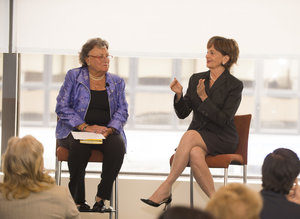

Speaking at the Women Corporate Directors (WCD) Global Institute this summer, Susan Stautberg the organisation’s CEO spoke on what could be done to help bring more female talent to the boardroom and to break down existing ‘patriarchal fortresses’. Stautberg stated, “Diverse boards can make a difference, not only around that table but in the world and for the world.”
Gender diversity—more than words
Lack of gender diversity is a point that progressive organisations are taking on board—literally and metaphorically. The likes of Goldman Sachs and McKinsey have not merely accepted the need for gender diversity but proactively champion it as part of their core values. On its website, for example, Goldman Sachs states, “Diversity is at the very core of our ability to serve clients well and to maximise return for our stakeholders.” It adds, “Diversity supports and strengthens the firm’s culture and reinforces our reputation as the employer of choice in our industry and beyond.”
Some, however, are more sceptical about such claims. Lelia Konyn, Consultant, People Strategies for Business Performance pointed out that although statements of gender diversity and diversity programmes are steps in the right direction—in many organisations—the results may be somewhat lacking. In one of the MNCs analysed by Konyn the senior management team had white American males accounting for nine out of 10 of its executive officers—with only one female African American present. Further to this, its 35-strong management committee only had five women on it and 10 out of 12 of its board directors were male. Konyn commented, “There probably is equal opportunity at the organisation—it is just more equal for men than for women.”
Positive movement
There is some evidence that the situation is beginning to improve in this respect and one of the key statistics that emerged from the Family Business Governance Institute, which runs in parallel with the WCD, was that while in 1992, women only made up 2% of all CEOs in family businesses, today the figure stands at 11-12%. The increase, while encouraging does still show a huge gap in terms of equality in the workplace and speaks volumes of the problem of the patriarchal culture which still pervades many organisations.
In terms of getting women promoted to the board, at the Global Institute, Maggie Wilderotter, Executive Chairman, Frontier Communications and Board Member at Xerox, Procter & Gamble and Juno Therapeutics spoke about the need to get women prepared for board service—taking risks on them and giving them room to develop
Practical measures
Speaking to HR Magazine after the WCD event, Stautberg suggested some tips for HR to help increase gender diversity, “Nominating committees can ensure that their director slates include diverse candidates beyond the ‘usual suspects’. CEOs and other individual directors—men and women—can champion women they know for board opportunities.” She highlighted that board succession needed to be a top priority—focusing attention on getting the most qualified directors who can bring diverse perspectives needed for success.
Pipelines not quotas
This strategy certainly has weight but would the WCD go as far as to call for set quotas globally? Stautberg disagreed, “In the last global board survey we conducted in 2012, our membership was not in favour of quotas: only 39% of women directors supported the use of quotas—and only 18% of male directors we surveyed.” She added, “Quotas have been popular in certain countries, but they are certainly not the answer across the board.” In fact, she pointed to development as being the key strategy, “Building the pipeline of talent and developing that talent pool of qualified women is essential.”
Getting onto the board is one thing but sometimes even just turning up as a woman in business can be particularly challenging. Speaking to delegates, Dr Herta von Stiegel, Founder and Executive Chair, Ariya Capital, shared her pleasant surprise while in Africa at the representation of women in East African governments. But despite this progress, she added, “It’s still a very, very patriarchal environment. If you show up as a woman in business, you’re still often thought of as ‘Plan B’ or ‘Plan C.’ But women are progressing—they are moving forward. There is a sense of ‘we need to be at the table’.”






